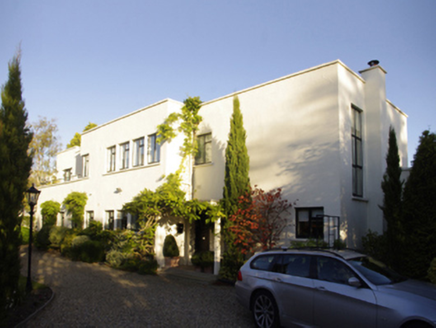Survey Data
Reg No
60230067
Rating
Regional
Categories of Special Interest
Architectural, Artistic
Original Use
House
In Use As
House
Date
1935 - 1940
Coordinates
321434, 226424
Date Recorded
12/04/2016
Date Updated
--/--/--
Description
Detached four-bay two-storey flat-roofed house, built 1939, on an L-shaped plan with two-bay two-storey advanced end bay; single-bay single-storey flat-roofed flush wing (north); single-bay single-storey flat-roofed recessed end bay (south). Extended, 2000-1, producing present composition. Flat bitumen felt roofs behind parapets with concealed rainwater goods. Square-headed door opening with two cut-granite steps, and concealed dressings with cantilevered canopy on monolithic post framing "porthole" timber door. Grouped square-headed window openings (north) with concrete sill courses, and concealed dressings framing casement windows. Square-headed window openings (remainder) with concrete sills, and concealed dressings framing casement windows. Set in landscaped grounds with rendered octagonal piers to perimeter having polygonal capping supporting iron double gates.
Appraisal
A house representing an important component of the mid twentieth-century domestic built heritage of south County Dublin with the architectural value of the composition, one showing the development of Knocksinna as a so-called "International Style suburb" (cf. 60230066; 60230068 - 60230073), confirmed by such attributes as the "cubic" plan form; the film strip-like grouped openings on each floor; and the parapeted flat roof. Cranleigh was built for Arthur J. Thornton (Thom's Directory of Ireland 1939, 1656) and its design has been attributed to the office of Michael Scott (1905-89) owing to similarities with the Scott-designed Geragh (1937-8) on Sandymount Point including the clever use of the site; the canopied doorcase; the grouping of the near-square openings; the elongated opening lighting the stairs; and the flat roofline. Scott and Thornton were both regulars on the Dublin theatre scene with the latter playing the organ in the Regal Rooms Cinema (1934-5) designed by the former (pers. comms. Vincent Delany 2024).

